|
Shocker of a Lifetime
by Franne Brandon,
Petersburg, Tennessee
This story was first printed in the
April 2012 Canadian Walking Horse News and later in the Heritage
Highlights Magazine
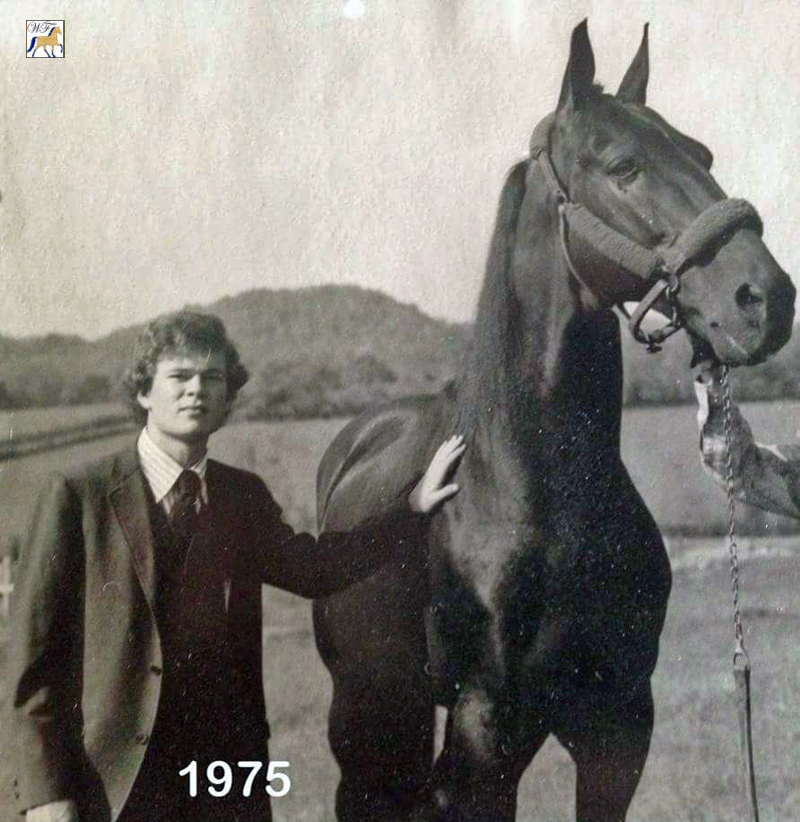 It
was September 3, 1966, and the darkened arena at the Tennessee
Walking Horse National Celebration grounds in Shelbyville,
Tennessee, heralded the moment when the judges’ cards would
reveal the new World Grand Champion. As the spotlights flashed
on, announcer Emmett Guy’s voice reverberated with the
traditional monologue “And the 1966 Grand Champion of the World
is number 35…..” The roar that went up from the crowd drowned
out the rest of the announcement, words that marked the
culmination of a feat not duplicated within competition in the
Tennessee Walking Horse breed from the 1939 blue ribbon win by
Strolling Jim to 2011. The story began almost twenty-three years
before the championship competition. On November 20, 1942, in
Manchester, Tennessee, a baby girl was born to Henry Pearl and
Virginia Wright Sain. The Sains named their new daughter
Elizabeth Faye. Three years later, the family moved from
Manchester to Bell Buckle, a small town in a rural area of
Bedford County, Tennessee. Having grown up in a small town in
the forties, Elizabeth Faye, now known as Betty, recorded her
memories in a hand-written, as yet unpublished, journal. She
writes “Growing up in the 1940’s was a lot different than the
life of today. Radio was your source of news, and word of mouth,
and newspapers. We had an eight party telephone line, and each
had their own number of rings. It was before TV.” It
was September 3, 1966, and the darkened arena at the Tennessee
Walking Horse National Celebration grounds in Shelbyville,
Tennessee, heralded the moment when the judges’ cards would
reveal the new World Grand Champion. As the spotlights flashed
on, announcer Emmett Guy’s voice reverberated with the
traditional monologue “And the 1966 Grand Champion of the World
is number 35…..” The roar that went up from the crowd drowned
out the rest of the announcement, words that marked the
culmination of a feat not duplicated within competition in the
Tennessee Walking Horse breed from the 1939 blue ribbon win by
Strolling Jim to 2011. The story began almost twenty-three years
before the championship competition. On November 20, 1942, in
Manchester, Tennessee, a baby girl was born to Henry Pearl and
Virginia Wright Sain. The Sains named their new daughter
Elizabeth Faye. Three years later, the family moved from
Manchester to Bell Buckle, a small town in a rural area of
Bedford County, Tennessee. Having grown up in a small town in
the forties, Elizabeth Faye, now known as Betty, recorded her
memories in a hand-written, as yet unpublished, journal. She
writes “Growing up in the 1940’s was a lot different than the
life of today. Radio was your source of news, and word of mouth,
and newspapers. We had an eight party telephone line, and each
had their own number of rings. It was before TV.”
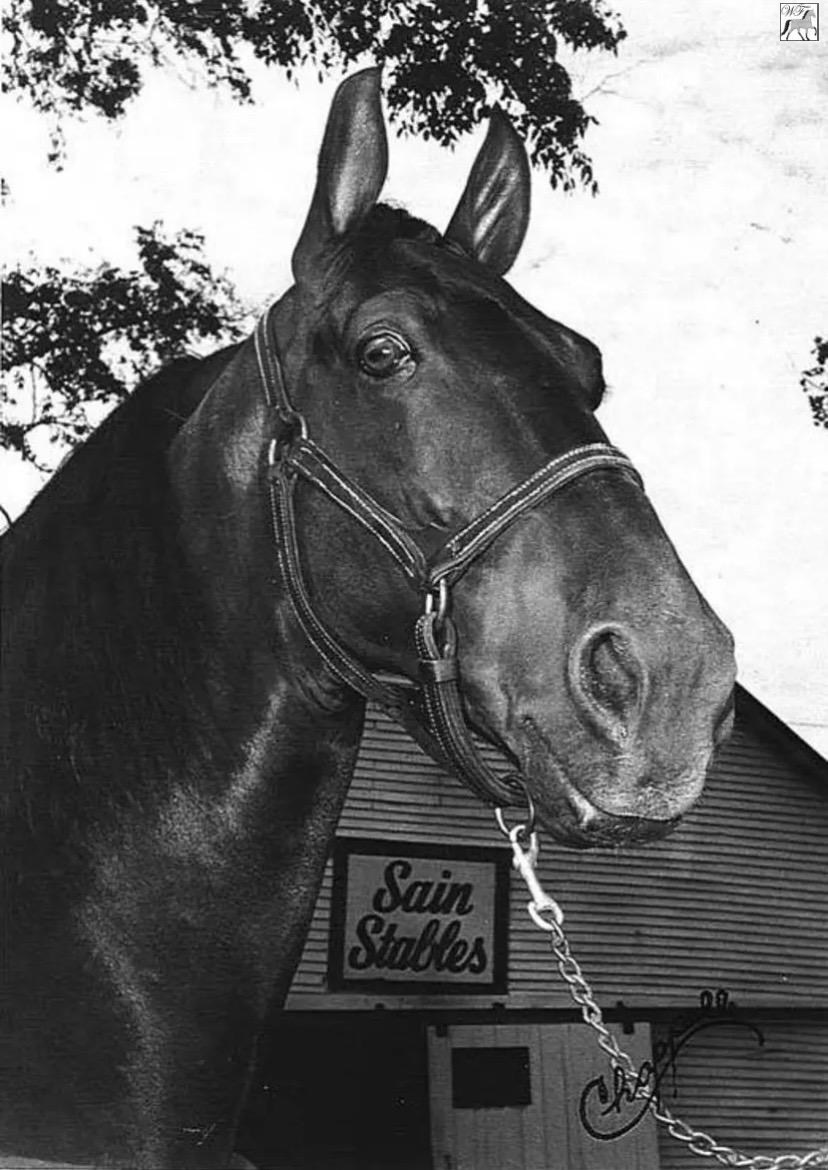 She also writes “The big Saturday night treat was to go to
Manchester, to see Gene Autry and Roy Rogers movies, while the
parents visited with Grandmother Sain. My brother and I would
fuss and fight over who was King of the Cowboys. I was Gene
Autry and Champion, Gal – even named my special filly of Polly,
a black and white pony, Champion. However, Brother insisted that
Roy and Dale and Trigger were the best – so many debates which
did not ever get a compromise from either of us. Riding all over
the farm, and creeks, and hills were the greatest way to grow
and dream. Riding on the backs of my steeds gave great learning
and confidence. Each and every animal taught you some things to
remember. You could ride the roads to neighbors, or town, or
kinfolks, and the people in the vehicles respected animals on
the road.” (Journal,”Forward”) She also writes “The big Saturday night treat was to go to
Manchester, to see Gene Autry and Roy Rogers movies, while the
parents visited with Grandmother Sain. My brother and I would
fuss and fight over who was King of the Cowboys. I was Gene
Autry and Champion, Gal – even named my special filly of Polly,
a black and white pony, Champion. However, Brother insisted that
Roy and Dale and Trigger were the best – so many debates which
did not ever get a compromise from either of us. Riding all over
the farm, and creeks, and hills were the greatest way to grow
and dream. Riding on the backs of my steeds gave great learning
and confidence. Each and every animal taught you some things to
remember. You could ride the roads to neighbors, or town, or
kinfolks, and the people in the vehicles respected animals on
the road.” (Journal,”Forward”)
In that much simpler time, she recalls that “Fairs and horse
shows were real social events all over our areas”, and that
“People would go on a Ridea-Thon and prided their horse, and
dress, and picnicked.” The times changed, however, and by the
late fifties, the main avenue for use of the Tennessee Walker
was the show ring. The Sain family had a select group of walking
horses at this time. In the spring of1962, Pearl Sain and Betty
learned that Tom Barham of Lewisburg, Tennessee, had bred his
Hunter’s Allen linebred mare named My Darling to Mack K’s
Handshaker.
They greatly admired Handshaker as an individual, and so My
Darling’s foal was “spoken for well in advance to his foaling.”
Breeder Barham registered as Handshaker’s Nodder, and the
youngster went to his new home in Bell Buckle in October of
1962. Betty, however, did not particularly like the colt’s name.
She states emphatically that “Handshaker’s Nodder did not suit
him. He was too regal. And he did it.” – that exemplary loose
and flashy movement that people looked for in that era in a show
prospect. Betty changed the colt’s official name in the TWHBEA
records from Handshaker’s Nodder 621314 to Shaker’s Shocker.
Many fine youngsters by Mack’s K’s Handshaker, the 1960 World
Grand Champion, were successful in the show ring in the sixties.
What set Shaker’s Shocker in a class by himself was his
lifestyle. When Shocker was coming two, he was not sent to any
of the trainers in the area in preparation for two year old
competition. Betty Sain herself started Shocker under saddle,
and trained the colt for two year old classes. He had a
successful show season as a two year old. On June 6, 1964, he
placed third at the Baxter Show in Cookeville, Tennessee.
Although he failed to earn a ribbon at the Goodletsville show on
June 19th, he took first at the prestigious Wartrace show on
August 1, and a week later, earned another blue in Geraldine,
Alabama.
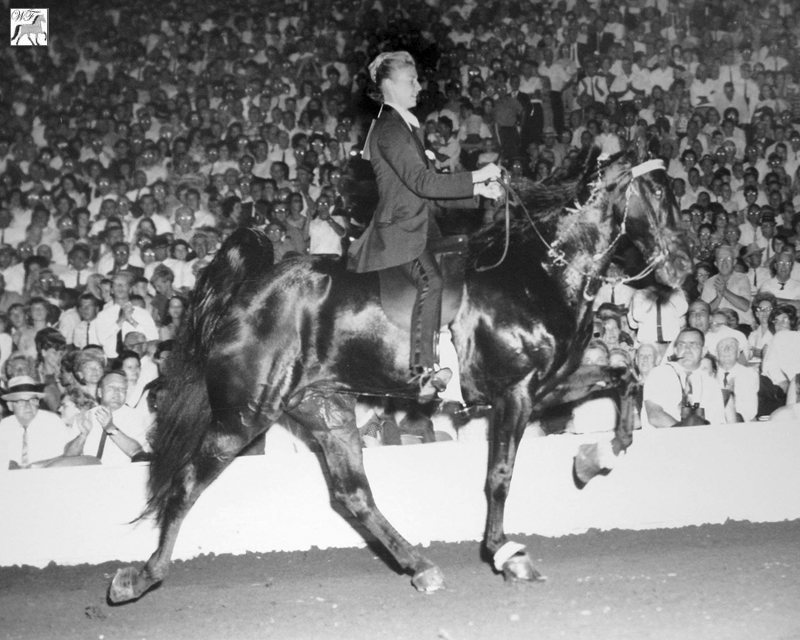
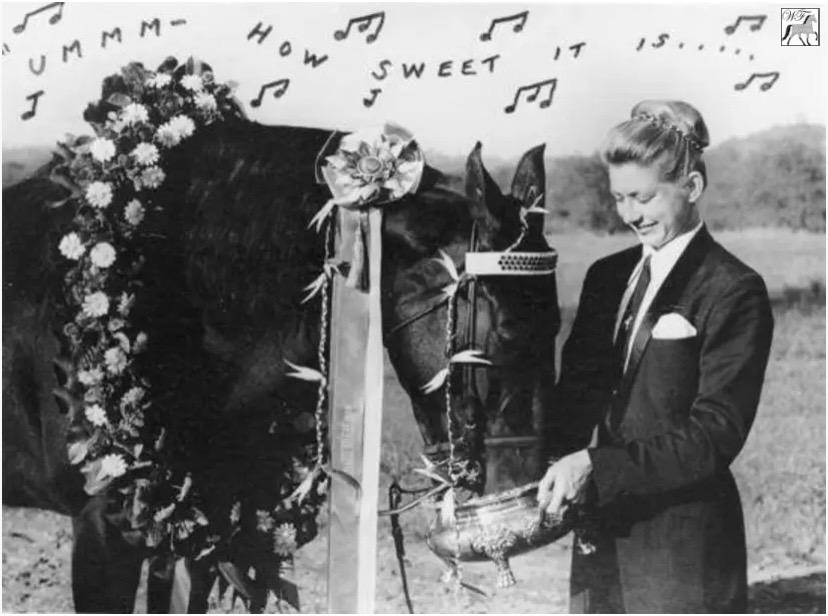 In 1965, when Shocker was three, all three year old horses were
still considered Junior Horses in the show ring. They were
required to canter, but not compete with the Aged Horses that
were four and over. Shocker also had a very bright junior season
in 1965. Starting on May 21st, he received first place at
Lewisburg,. On June 29, at Lafayette, he got fifth. On August 6,
at the highly regarded Belfast show, he earned another blue
ribbon. After placing fifth in the junior stallion preliminary,
his Celebration competition culminated in winning the Reserve
World Championship at the Tennessee Walking Horse National
Celebration, with owner-trainer Betty in the irons for this
significant victory. In the past, holding the title of Junior
World Champion or Reserve Junior World Champion walking horse
marked these youngsters as major figures to be watched in
competition the following spring when the first gates opened for
Aged Walking Horse competition. In 1965, when Shocker was three, all three year old horses were
still considered Junior Horses in the show ring. They were
required to canter, but not compete with the Aged Horses that
were four and over. Shocker also had a very bright junior season
in 1965. Starting on May 21st, he received first place at
Lewisburg,. On June 29, at Lafayette, he got fifth. On August 6,
at the highly regarded Belfast show, he earned another blue
ribbon. After placing fifth in the junior stallion preliminary,
his Celebration competition culminated in winning the Reserve
World Championship at the Tennessee Walking Horse National
Celebration, with owner-trainer Betty in the irons for this
significant victory. In the past, holding the title of Junior
World Champion or Reserve Junior World Champion walking horse
marked these youngsters as major figures to be watched in
competition the following spring when the first gates opened for
Aged Walking Horse competition.
The rules changed before the first shows of 1966, however. For
the first time, in 1966, all four year old horses were
considered “Junior Horses”. Shocker and his foal crop would
compete yet another year as junior horses, and not be required
to compete with the older, more experienced animals. The former
junior horses would now be exhibited in classes for three year
olds, and not required to canter. Instead of being an important
contender for World Grand Championship honors, Shocker became a
leader in the race to be crowned the first Four Year Old Junior
World Champion.
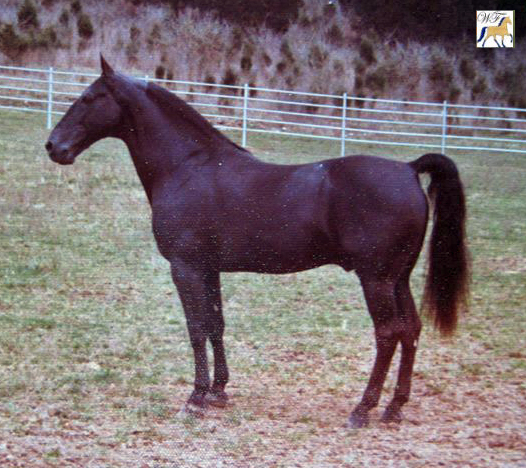 Whatever the goal, however, Betty Sain approached his training
in the same way. She explains that to train a champion, one must
“start with a good horse. Then it is patience and common sense.
He was a big, powerful horse.” Even as a four year old, Shocker
had height, size, and bone. Betty took advantage of his strength
and determination to fully condition the big stallion with
workouts six days a week. She recalls “our workouts were an hour
and a half, at least, ...in a great, big, open field.” Since the
show shoeing for the sixties was much smaller and tidier than
the stacks wore by show walkers in the 21st century, Shaker’s
Shocker could readily travel through weeds and over small rocks
while maintaining balance and that wonderful four beat rhythm.
Sain emphasizes “He was never in a ring except at a horse show.”
Over time, the black stallion developed a powerful way of going
and the stamina to produce this show gait far longer than other
contenders whose shorter workout times generally involved
circles of a practice ring or trips up and down a barn aisle. Whatever the goal, however, Betty Sain approached his training
in the same way. She explains that to train a champion, one must
“start with a good horse. Then it is patience and common sense.
He was a big, powerful horse.” Even as a four year old, Shocker
had height, size, and bone. Betty took advantage of his strength
and determination to fully condition the big stallion with
workouts six days a week. She recalls “our workouts were an hour
and a half, at least, ...in a great, big, open field.” Since the
show shoeing for the sixties was much smaller and tidier than
the stacks wore by show walkers in the 21st century, Shaker’s
Shocker could readily travel through weeds and over small rocks
while maintaining balance and that wonderful four beat rhythm.
Sain emphasizes “He was never in a ring except at a horse show.”
Over time, the black stallion developed a powerful way of going
and the stamina to produce this show gait far longer than other
contenders whose shorter workout times generally involved
circles of a practice ring or trips up and down a barn aisle.
As the Celebration competition began in on Friday, August
26, 1966, the shock of the show proved to be not only the
horse’s name but his management as well. Betty Sain had elected
not to exhibit Shaker’s Shocker at any of the one night shows
that served as precursors to the Celebration. She realized as
others also did that one judge’s opinion at a show in May or
June could adversely affect the big horse’s status when he was
entering the ring in August. When the class for Junior Stallions
was announced on Wednesday night, August 31st, an untested
Shaker’s Shocker entered the ring with the other four year old
stallions, and emerged with the blue (1st place) ribbon and the
silver. He became the favorite horse to win the Junior World
Championship, to be held two nights later, on Friday, September
2 nd. That was when owner/trainer Sain made a second “shocking”
decision, to withhold her big black from the junior championship
and to pay the larger entry fee for the World Grand Championship
on Saturday night, for which they had qualified, according to
Celebration rules, by winning the Junior Stallion blue ribbon.
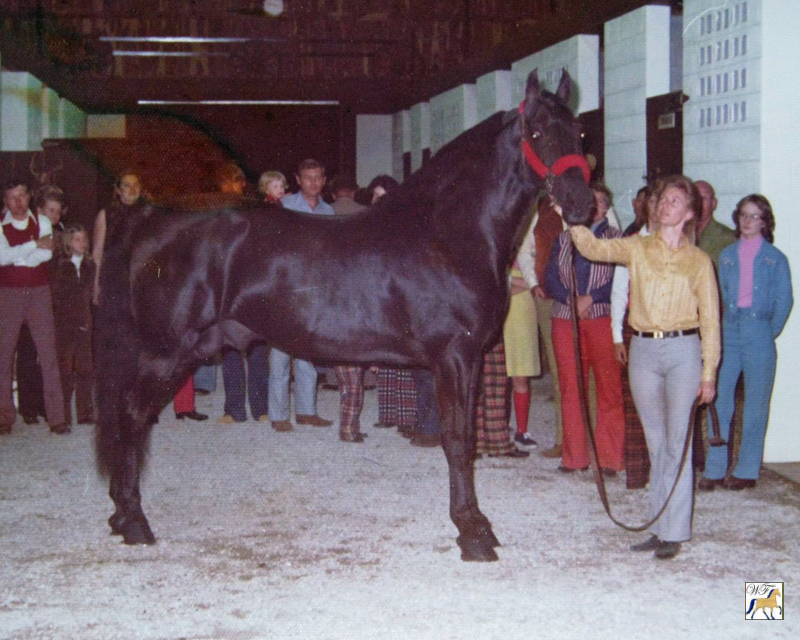 It was standing room only, all boxes, reserved seats and general
admission seats filled, when the contenders for the 1966 World
Grand Championship entered the Celebration arena on the night of
September 3rd. Sain was competing against other well-known black
stallions, winner of the Aged Stallion class Johnny Midnight and
that class’s reserve champion Go Boy’s Royal Heir. Also in
contention were Duke’s Handyman, trained by Hershell Talley, and
Go Boy’s Sundust, shown by Bud Dunn. The bright bay Go Boy’s
Chatterbox was also among the horses that made the final cut to
the workout. When the dust settled after three grueling workouts
and the roars of the crowd settled to the expectant silence
preceding the announcer’s change from conversation to class
results, the lights darkened, the spotlights swept the ring, and
it was Betty Sain and Shaker’s Shocker, only a four year old but
obviously in charge in terms of strength, stamina, and ability,
who were announced as the winners. At the time, Betty was twenty
three years old, the second youngest rider to win the World
Grand Championship, and the first woman to ride for the roses.
Only two other women, Judy Martin Wiser and Vicky Self, both
professional trainers, have ever duplicated her success in the
ensuing years. It was standing room only, all boxes, reserved seats and general
admission seats filled, when the contenders for the 1966 World
Grand Championship entered the Celebration arena on the night of
September 3rd. Sain was competing against other well-known black
stallions, winner of the Aged Stallion class Johnny Midnight and
that class’s reserve champion Go Boy’s Royal Heir. Also in
contention were Duke’s Handyman, trained by Hershell Talley, and
Go Boy’s Sundust, shown by Bud Dunn. The bright bay Go Boy’s
Chatterbox was also among the horses that made the final cut to
the workout. When the dust settled after three grueling workouts
and the roars of the crowd settled to the expectant silence
preceding the announcer’s change from conversation to class
results, the lights darkened, the spotlights swept the ring, and
it was Betty Sain and Shaker’s Shocker, only a four year old but
obviously in charge in terms of strength, stamina, and ability,
who were announced as the winners. At the time, Betty was twenty
three years old, the second youngest rider to win the World
Grand Championship, and the first woman to ride for the roses.
Only two other women, Judy Martin Wiser and Vicky Self, both
professional trainers, have ever duplicated her success in the
ensuing years.
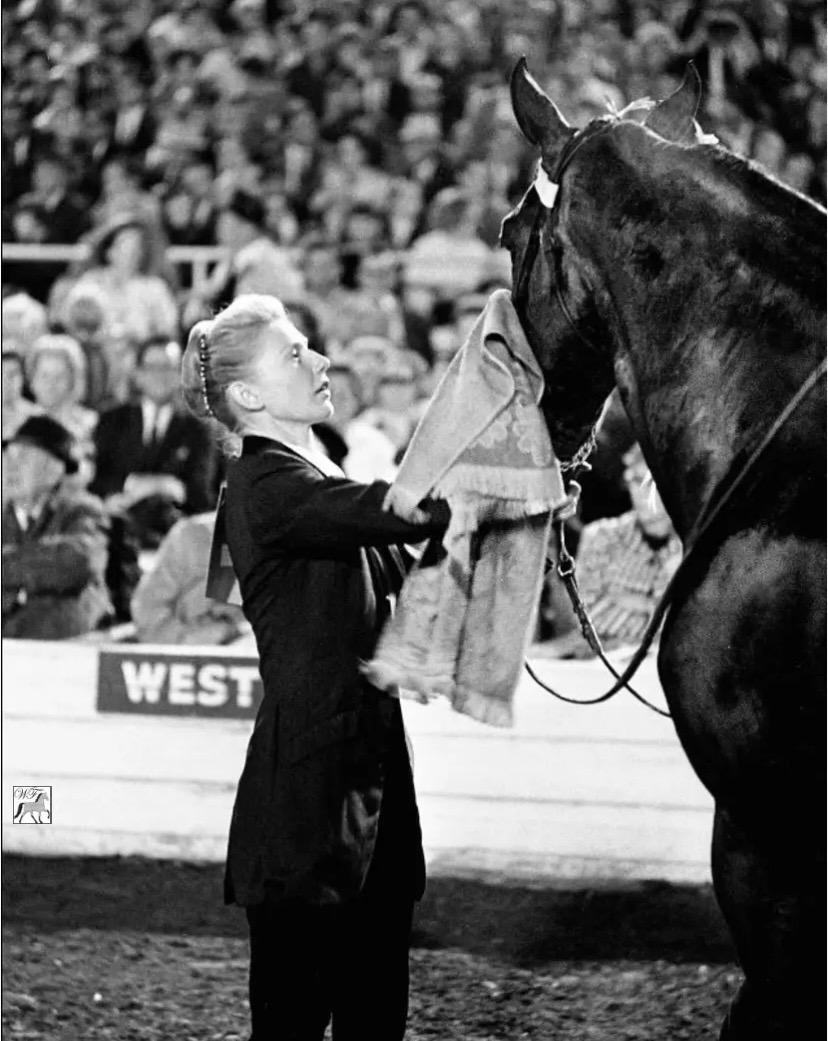
Betty Sain chose to not retire Shaker’s
Shocker the year following his historic victory. She continued
to campaign him throughout the Southeast until his formal
retirement ceremony in Montgomery, Alabama, at the Southern
Championships, in 1970. While his first foal crop had arrived in
1969, in 1971, Shocker was no longer in show training, but
focused on a new career in the stud. The times in the seventies
were changing, though, and unlike many of her contemporaries,
Betty Sain, ever a woman of vision, recognized the importance of
these changes and adapted her mission to embrace them and a new
outlook for the Tennessee Walking Horse breed she loved so well.
To be continued…..
Sources – interview with Betty Sain on
February 29, 2012 Sain, Betty. Journal. The Nashville Banner,
Celebration coverage, 1966 (author’s scrapbook)
http://pleasuregaits.com/images/Heritage_Highlights/July%202012%20Heritage%20Highlights.pdf
|